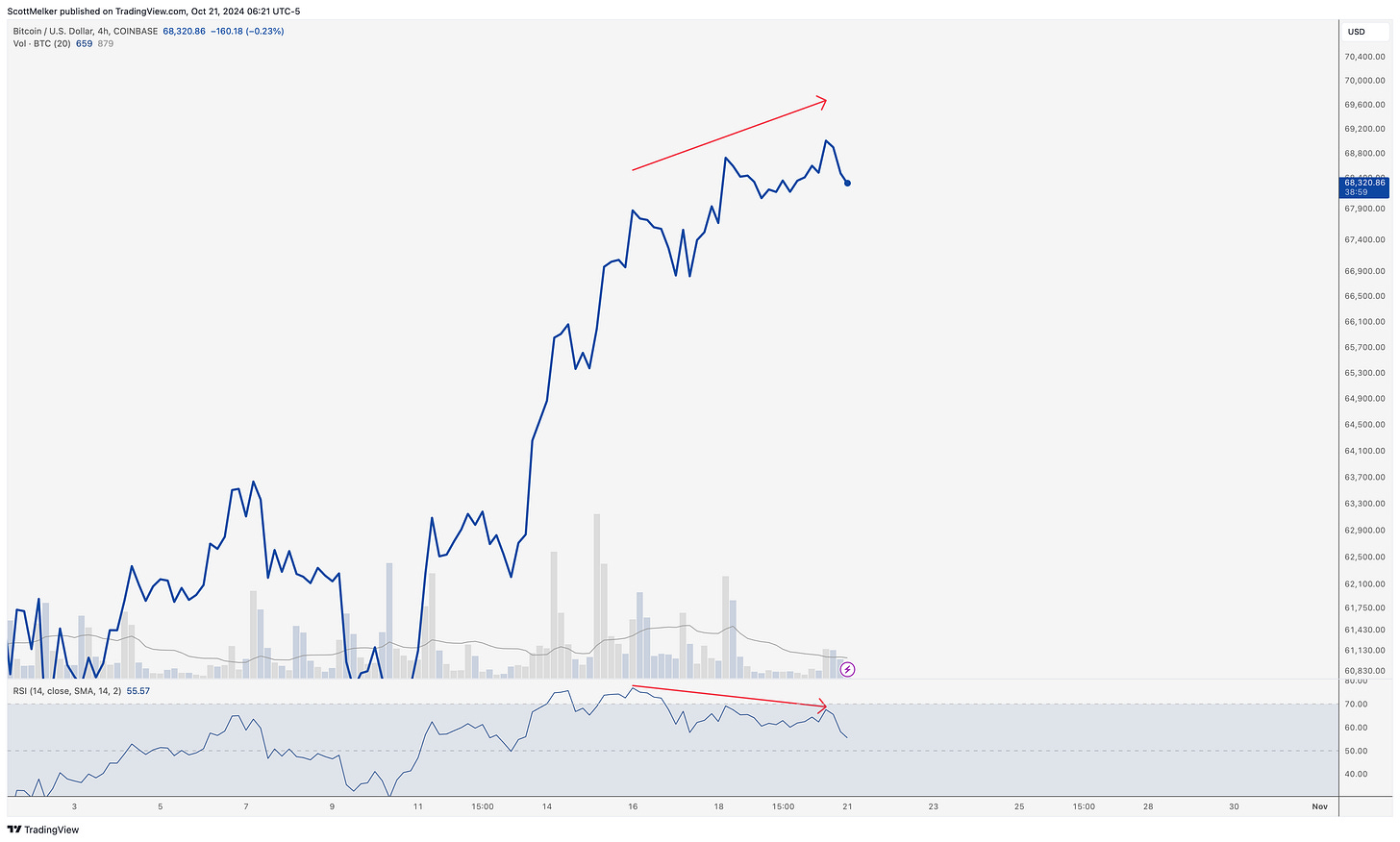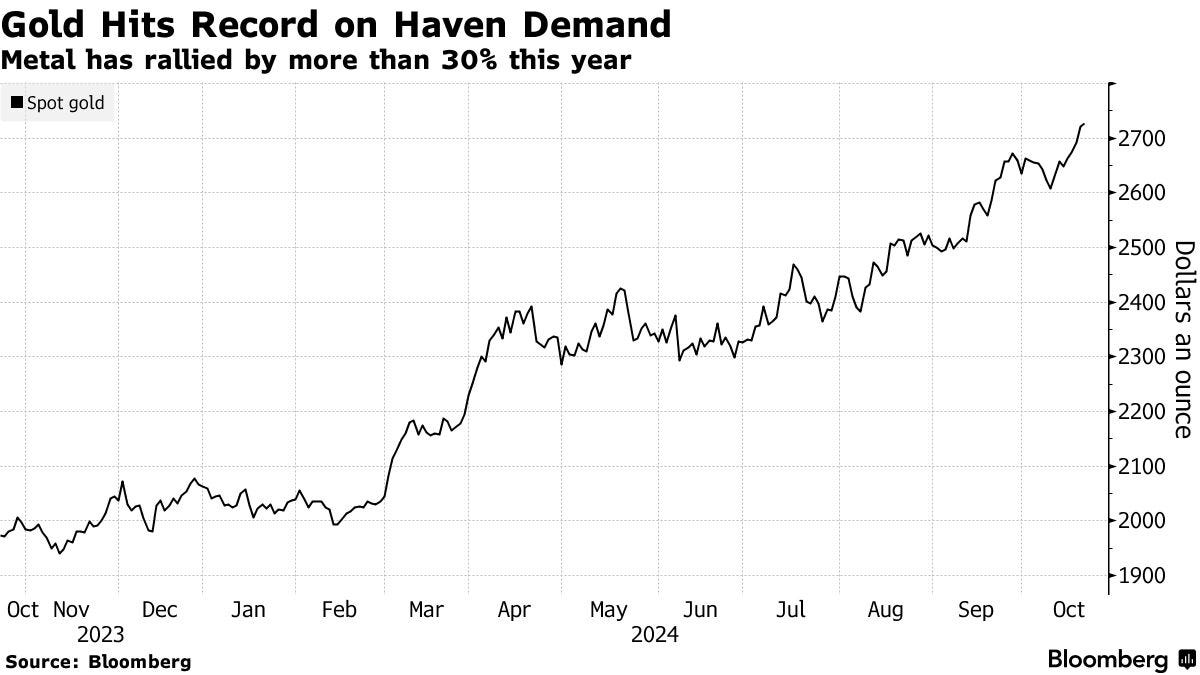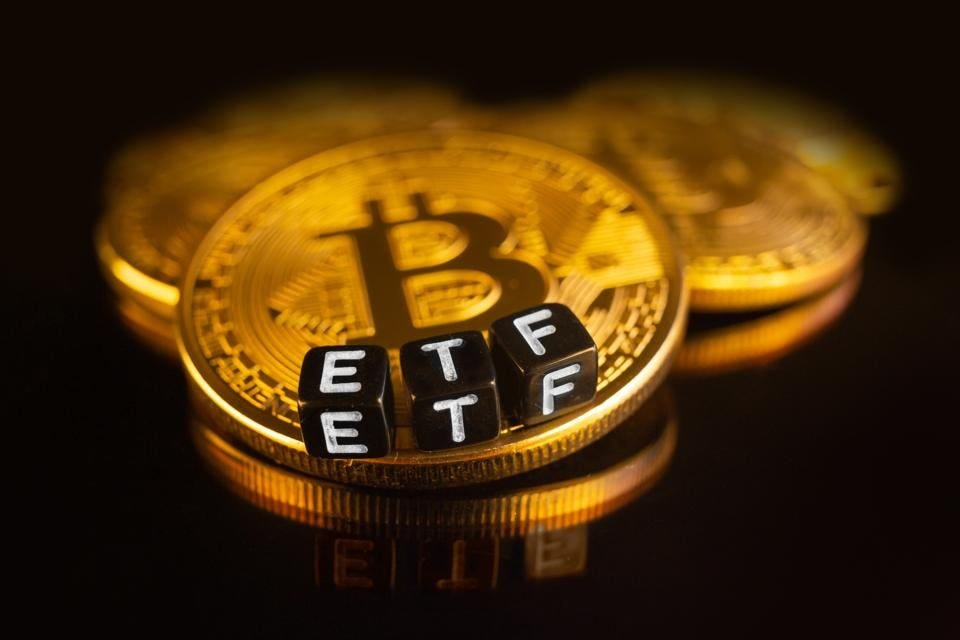Welcome to The Wolf Den! This is where I share the news, my ideas about the market, technical analysis, education and my random musings. The newsletter is released every weekday and is completely FREE. Subscribe!
Today’s Newsletter Is Made Possible By Arch Public!
Another aggressive move higher on Friday for our Arch Public Concierge Program clients. NQ/MNQ +5% which puts the total return for the past 70 days at +36%. All of it with a focus on liquidity and tight stop loss protection.
Try Arch Public now! You can even demo the platform, for free, to learn more.
In This Issue:
When Should You Sell?
Bitcoin Thoughts And Analysis
Legacy Markets
The ETFs Are Cooking
BlackRock Plans To Use BUIDL As Collateral
Tether Crosses $120B
Silver Breaking Out - And Breaking Banks
Here's Why Stablecoins Are THE KILLER APP For Crypto | Jeremy Allaire
When Should You Sell?
Everyone knows about dollar-cost averaging—it’s not a new concept. But there's a critical second half to the strategy that many traders and investors overlook: selling. Getting this wrong can be an expensive mistake.
In the thousand-plus newsletters I’ve written, I haven’t delved deeply into this perspective on selling until now, but it feels like the right time. I’m not telling you to sell, but I am suggesting it’s wise to start considering an exit strategy if it aligns with your goals.
Let’s start with the basics before we dive into the part that might blow your mind. If you’re familiar with dollar-cost averaging, you might be tempted to skip the next section. But even if you consider yourself an expert, stick with me—you might learn something new.
Dollar-Cost Averaging: A Strategic Approach to Buying and Selling Assets
Dollar-cost averaging (DCA) is one of the most commonly taught investment strategies and can offer substantial benefits in any market when building a position. The idea is simple: invest a fixed dollar amount at regular intervals, which helps mitigate the risks associated with market volatility. However, when it comes to selling, most people get it wrong—this is where the strategy requires a different approach. Let’s unpack why.
The Buying Mindset: Fixed Dollar Amounts
DCA works best when you're buying in fixed dollar amounts. This allows you to accumulate shares at varying prices, which lowers the average cost per share over time.
For example, imagine an asset spends half its time at $5 and the other half at $10. If you invest $100 all at once, you’ll either get 20 shares at $5 or 10 shares at $10, with an average cost of $7.50 per share. But if you use the DCA approach, investing $10 at a time, your average cost per share drops to $6.67.
This happens because you buy more shares when the price is lower and fewer when it’s higher. So, if the price is $5, your $10 buys 2 shares; if it’s $10, it buys 1 share. Over multiple purchases, this skews your average cost downward because you’re acquiring more shares at the lower price. Statistically, you’ll end up with two-thirds of your shares at $5 and one-third at $10, for an average price of $6.67.
Most people understand this part, but the real challenge comes when it’s time to sell.
The Selling Strategy: Fixed Units Over Dollar Amounts
The mindset of buying in fixed dollar amounts doesn’t translate well to selling. If you sell in fixed dollar increments, you end up selling more shares when the price is low and fewer when it’s high—exactly the opposite of what you want.
Using the same example, if you own 15 shares and decide to sell in $10 increments, you’ll be forced to sell more shares at $5 and fewer at $10, which drags down your overall returns. Instead of getting the $7.50 average price you expect, you might end up closer to $6.67.
The better approach is to sell in fixed units. By selling half your shares at $10 and half at $5, you lock in an average sale price of $7.50—exactly what you want. This approach captures more value at the higher price and optimizes your returns.
Why Selling Matters as Much as Buying
In summary, while dollar-cost averaging works well for buying, selling demands a different strategy—one that focuses on selling in fixed units rather than fixed dollar amounts. This small shift can have a big impact on your overall returns.
Of course, this simplified example assumes the asset's price doesn't rise, and real-life decisions around selling involve far more than just numbers. Factors like personal obligations, market sentiment, timing, locked assets, breaking news, and even debt can influence when and how you sell.
And sure, if you think you can outsmart the math with a perfectly timed sale, go for it. But the reality is, most people—likely over 95%—won’t be able to consistently beat this strategy or time the market. What works is sticking to the principles that most others ignore.
We’re all navigating a complex and unpredictable market, and any edge that simplifies decision-making is worth adopting. For some of you, internalizing this approach could mean the difference of hundreds, thousands, or even hundreds of thousands of dollars in returns.
Bitcoin Thoughts And Analysis
We have had conspicuous bearish divergence with overbought RSI during the climb from $67,000 to $69,000. No surprise that we are seeing a pause or retrace before an attempted move above $70,000, which is the key level.
It is likely we will see hidden bullish divergence if price stays here or goes lower - a lower low on RSI and a higher low on price, which would cancel the bearish divergence.
Legacy Markets
US stock futures edged lower as investors focus on a week packed with major earnings reports, including Tesla, Boeing, and Coca-Cola. The S&P 500 futures dropped 0.3%, and Nasdaq 100 futures fell 0.5%. Tensions in the Middle East are driving oil prices higher and pushed gold to a record high. The US 10-year Treasury yield also rose slightly.
European stocks, represented by the Stoxx 600, fell 0.5%, with less positive earnings surprises than usual, contributing to cautious investor sentiment. Goldman Sachs strategists warned that US stocks might not maintain their strong performance due to a shift toward bonds and other assets.
Notable corporate moves include Boeing's shares rising 4.5% after a tentative union agreement, and Kenvue shares jumped 5% following news that activist investor Starboard Value is pushing for changes. Additionally, MetLife is in talks to acquire PineBridge Investments' non-China assets, valued between $1 billion and $1.5 billion.
Here are some highlights of the coming week:
IMF, World Bank annual meetings in Washington Monday through Oct. 26
BRICS summit in Russia, hosted by Russian President Vladimir Putin. Among those attending are the leaders of Brazil, India and China, Oct. 22 through Oct. 24.
Canada rate decision, Boeing, Tesla, Deutsche Bank earnings Oct. 23
Eurozone, UK, US PMIs
German IFO data, Tokyo CPI
Some of the main moves in markets:
Stocks
S&P 500 futures fell 0.3% as of 6:50 a.m. New York time
Nasdaq 100 futures fell 0.5%
Futures on the Dow Jones Industrial Average fell 0.2%
The Stoxx Europe 600 fell 0.5%
The MSCI World Index fell 0.1%
Currencies
The Bloomberg Dollar Spot Index rose 0.2%
The euro fell 0.2% to $1.0848
The British pound fell 0.2% to $1.3022
The Japanese yen fell 0.3% to 149.93 per dollar
Cryptocurrencies
Bitcoin fell 0.7% to $68,310.99
Ether fell 0.2% to $2,705.94
Bonds
The yield on 10-year Treasuries advanced four basis points to 4.13%
Germany’s 10-year yield advanced six basis points to 2.25%
Britain’s 10-year yield advanced five basis points to 4.11%
Commodities
West Texas Intermediate crude rose 2.1% to $70.65 a barrel
Spot gold rose 0.4% to $2,732.23 an ounce
The ETFs Are Cooking
There’s a reason we’ve seen so many ETF filings in crypto over the past few weeks—it’s because crypto ETFs are successful, no matter what the critics want to believe. Just this past week we have seen issuers submit applications for Litecoin, Ripple, and Grayscale’s Digital Large Cap Fund. In truth, Ethereum is only capturing a small fraction of what Bitcoin is pulling in; you can see the numbers below. It’s still pulling in A LOT OF flows relative to the vast majority of what’s out there, which makes it a huge success in its own right.
Bitcoin ETFs:
On Monday, October 14, spot Bitcoin ETFs saw $555.86 million worth of inflows, the highest daily inflows since June 4.
Total inflows for the week amounted to $2.18 billion, the fourth-highest weekly net flow since the ETFs' launch in January.
BlackRock’s IBIT received over $1.14 billion in inflows, maintaining its position as the largest spot Bitcoin ETF with cumulative net inflows of $22.84 billion.
Fidelity’s FBTC ranked second with inflows of $318.82 million.
Bitwise’s BITB attracted $149.81 million in investments.
Grayscale’s GBTC recorded $91.47 million in inflows, breaking a 21-week streak of outflows.
All other spot Bitcoin ETFs, except Hashdex’s DEFI, had inflows below $50 million.
Cumulative total net inflows of all spot Bitcoin ETFs stand at $20.98 billion.
Spot Bitcoin ETFs hold total net assets of $66.11 billion, equivalent to 4.89% of Bitcoin's market cap.
Ethereum ETFs:
Spot Ethereum ETFs saw weekly inflows of $78.98 million.
BlackRock’s ETHA led with $49.76 million in inflows.
Fidelity’s FETH came second with $43.52 million in inflows.
Spot Ethereum ETFs have a negative cumulative total net outflow of $479.99 million.
Spot Ethereum ETFs hold $7.35 billion in net assets, representing 2.31% of Ethereum’s market cap.
BlackRock Plans To Use BUIDL As Collateral
BlackRock is reportedly in early talks with several crypto exchanges, including Binance, OKX, and Deribit, to use its proprietary token, BUIDL, as collateral for derivatives contracts. On the news, RWA tokenization platform Ondo Finance’s governance token spiked 8%, which is seen as a favored proxy play to BUIDL. As a reminder, BUIDL launched in March and is a tokenized money-market fund built on Ethereum, designed to maintain a stable value of $1 per token and provide yields to traders. The fund invests in cash, US Treasury Bills, and repurchase agreements, with dividends distributed as new tokens. Robert Mitchnick, BlackRock's head of digital assets, described BUIDL as part of its broader digital asset strategy. Additionally, Circle introduced a function allowing BUIDL holders to convert their tokens into USDC, reducing costs and friction for investors. It will be fascinating to watch how BlackRock's digital asset division evolves over the next year, 5 years, and decade-plus.
Tether Cross $120B
It seems like just yesterday the crypto space was celebrating Tether reaching a $100 billion market cap, and now, only 7 months later, it has surged past $120 billion with no signs of slowing down. In just 7 months, Tether has achieved one-fifth of what it took a decade to reach, that’s pretty damn impressive. During that same period, from March until now, USDC, Tether's largest competitor, grew its market cap by about $5 billion, rising from $30 billion to $35 billion—a 16.67% increase compared to Tether’s 20% growth. Given that USDT is already four times larger than USDC, it will be especially challenging for USDC to close the gap, largely due to the significant difference in scale.
Silver Breaking Out - And Breaking Banks
Silver prices surged over 6% on Friday, surpassing $33.6 per ounce, which has put five major U.S. banks at risk of significant losses—potentially billions—due to their large short positions in the precious metal. With open interest in silver futures reaching 141,580 contracts—equivalent to nearly a year's global silver production—these short positions are now estimated to be underwater by $1.3 billion. Similarly, sources close to the matter report that gold futures are experiencing a comparable trend, with paper shorts down over $1.5 billion.
If there has ever been a time for Bitcoin to soar, now is the time.
Here's Why Stablecoins Are THE KILLER APP For Crypto | Jeremy Allaire
In this episode of The Wolf of All Streets, join us as we dive deep with Jeremy Allaire, CEO of Circle, who shares insights on stablecoins, regulatory challenges, and the future of digital finance. Filmed live in Singapore, we explore the pivotal role stablecoins like USDC play in the crypto world and how global financial landscapes are transforming.
My Recommended Platforms And Tools
Phemex - Exclusive for new users, earn up to 8800 USDT. Also for a limited time, if you mint your soul pass you will pay no gas fees and enjoy VIP benefits. Use MY LINK to get the rewards!
Arch Public - It’s a hedge fund in your pocket. Built for retail traders, designed to outperform Wall Street. Try emotionless algorithmic trading at Arch Public today.
Trading Alpha - Trade With Confidence! My new go-to indicator site and trading community. Use code '10OFF' for a 10% discount.
X - I spend most of my time on X, contributing to CryptoTownHall every weekday morning, sharing random charts, and responding to as many of you as I can.
YouTube - Home of the Wolf Of All Streets Podcast and daily livestreams. Market updates, charts, and analysis! Sit down, strap in, and get ready—we’re going deep
The views and opinions expressed here are solely my own and should in no way be interpreted as financial advice. Every investment and trading move involves risk. You should conduct your own research when making a decision. I am not a financial advisor. Nothing contained in this e-mail constitutes or shall be construed as an offering of financial instruments or as investment advice or recommendations of an investment strategy or whether or not to "Buy," "Sell," or "Hold" an investment.













